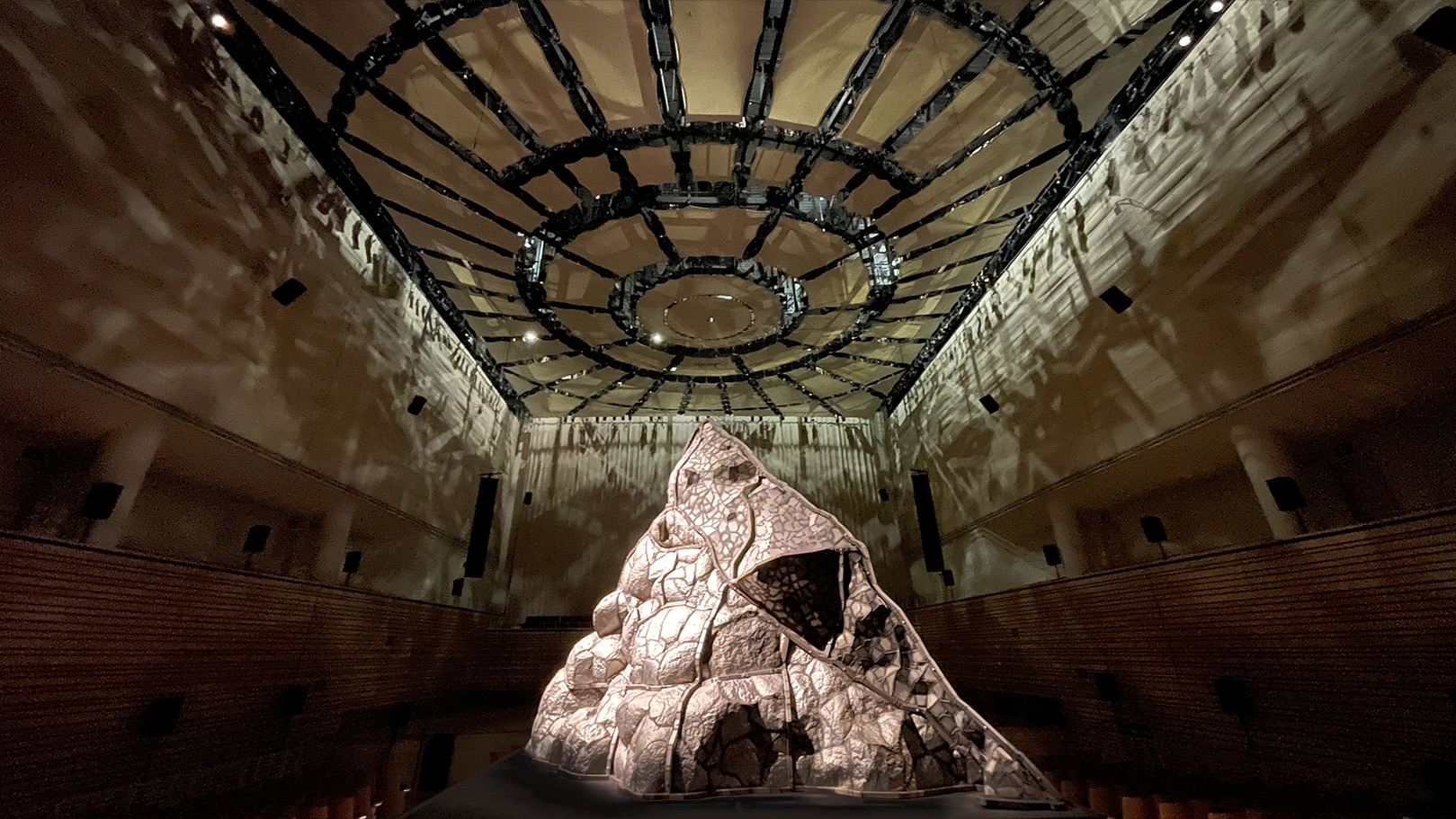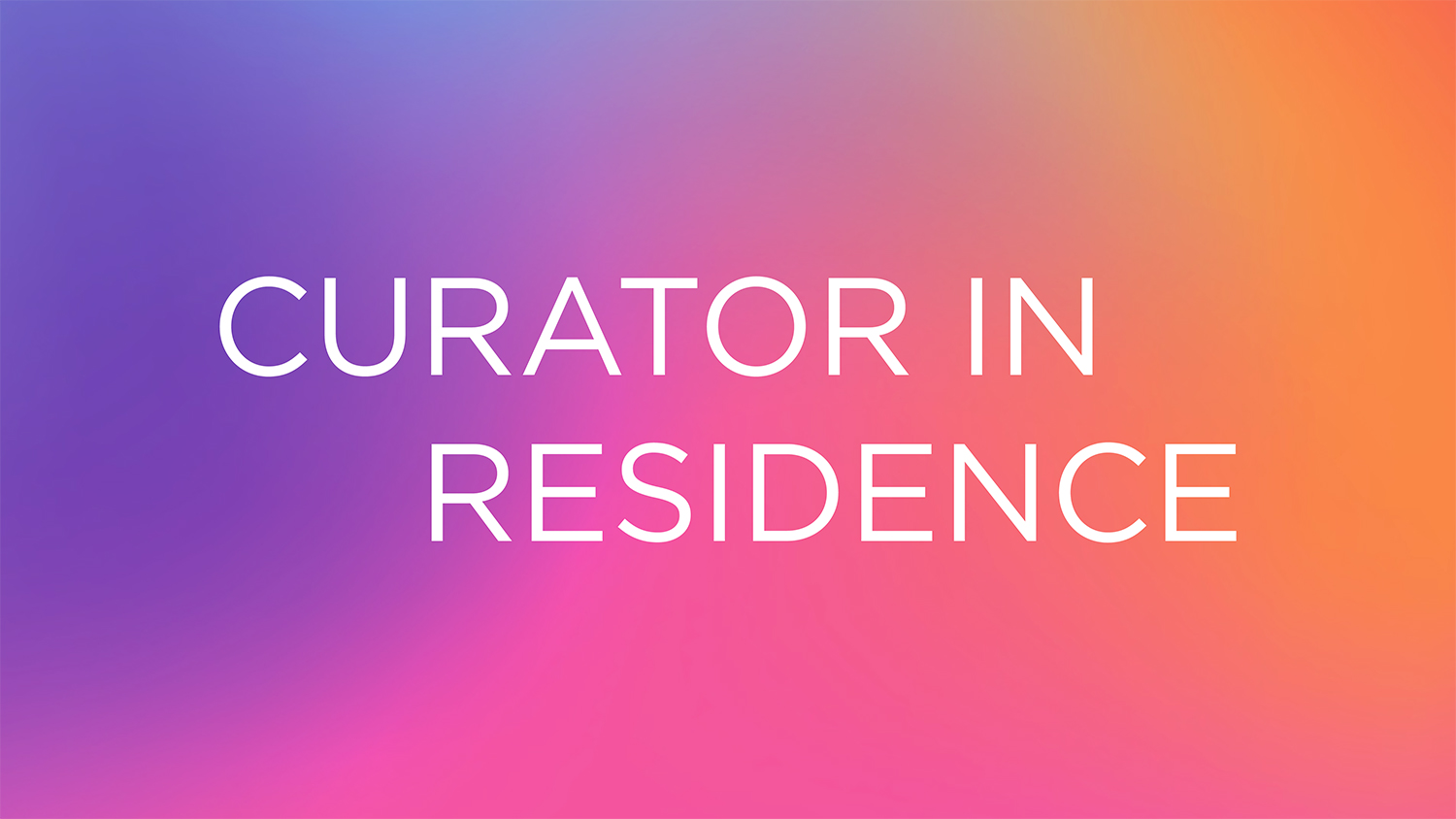
Shifting Center
Standing on a beach, facing the fierce south seas of Yogyakarta, Julian Abraham “Togar” captures the sound of a rock and films himself in the process. His microphone picks up the wind and the waves as they reflect their rhythm off the stony surface. As the recording is played back in Rocker’s Gonna Rock (2021), a question emerges: can we tune in to the rock or do we only hear the sea?
Drawing its title from a term in the field of acoustics that describes the perceived dislocation in the position of a sound source, Shifting Center stages processes of listening to infrasonic landscapes, acoustic architectures, and unsounded instruments across multiple scales of time. The exhibition poses sculpture as time-based and presents it with moving-image and spatial-audio installations across the concert hall, proscenium stage, and studios at EMPAC.
Research conducted alongside the exhibition by its curators Vic Brooks and Nida Ghouse considers two opposing tendencies: dislocation, or how objects, artworks, and cultural belongings are taken from their context and often silenced through museological mechanisms of preservation and display; and location, or how architectural acoustics impact exhibitions as resonant spaces of situated listening. Today, despite attempts to design “flexible” galleries for sound-making artworks as well as for performative or communal projects, contemporary exhibition spaces continue to inherit their sonic inadequacies from the visual priorities of the colonial museum.
Shifting Center engages the unique technical capacities of EMPAC, including its distinct acoustic properties, to address and destabilize some of these conventions. The exhibition plays with theatrical infrastructure and object-based sound technologies, such as higher-order ambisonics and wave field synthesis, to propose alternate techniques and practices to locate and listen to contemporary artworks that are themselves locating and listening to past events in the ever-changing present.
With contributions by Julian Abraham “Togar”, Tania Candiani, Padmini Chettur & Maarten Visser, Beatriz Cortez, Guillermo Escalón & Igor de Gandarias, Hugo Esquinca, Maurice Louca, Cannupa Hanska Luger, Nancy Mounir, Gala Porras-Kim, Micah Silver, and Clarissa Tossin & Michelle Agnes Magalhães, Shifting Center is choreographed not just in space but also time. It reaches across the disciplinary boundaries of the visual and performing arts to simultaneously inhabit their attendant temporalities, that is the event-based expectation of performance with the durational scale of an exhibition. It engages earlier experiments of deep listening and psychoacoustics by Pauline Oliveros (1932-2016) and Maryanne Amacher (1932-2016) at EMPAC through new works that approach the building as an instrument in itself.
The artworks in Shifting Center engage in the speculative construction of premodern and Indigenous instruments and repertoires, as well as the reconsideration of both geological formations and built architecture as actual sources of sounding. They listen to the material traces of not just cultural belongings but also tectonic and meteorological events. If the museum withdraws objects from their social uses and freezes them in time and place, the works follow such traces across multiple sites and extended temporal frames, moving between the seismic and the musical, the archeological and the cosmic.
Whether or not we can tune into the rock through the sounds of the sea, or to what degree we can listen to the histories carried by an object, the exhibition nonetheless attends to this acoustic potential. As Cannupa Hanska Luger puts it, a handful of clay can fill an entire room when modeled into a whistle, and as Igor de Gandarias’ transformation of subterranean infrasounds into an orchestral composition reminds us, the volcano performs for us every day as an instrument of the earth.
Shifting Center is curated by Nida Ghouse (curator-in-residence) and Vic Brooks (associate director of arts and senior curator of time-based visual art) with Katherine C. M. Adams (assistant curator) and M. Elijah Sueuga (curatorial fellow).
Main Image: Beatriz Cortez, Study for Ilopango, The Volcano that Left, 2023. Composite Image. Courtesy the artist and Commonwealth and Council. Photo: Phillip Bryne.
Dates + Tickets
EMPAC 2023 Fall
Ilopango, the Volcano that Left by Beatriz Cortez is co-commissioned by EMPAC–Curtis R. Priem Experimental Media and Performing Arts Center at Rensselaer Polytechnic Institute, Storm King Art Center, and the Vera List Center for Art and Politics at The New School. The sculpture was created in part while the artist was was in residence at Atelier Calder, Saché, France.
The sculpture’s journey up the Hudson River and its documentation for the forthcoming film by Guillermo Escalón is made possible by Teiger Foundation and is supported by a grant from the Simons Foundation. Additional program support is provided through the artist's Borderlands Fellowship at the Vera List Center for Art and Politics at The New School.
Shifting Center is made possible by Teiger Foundation.
Shifting Center is supported by a Curatorial Research Fellowship from The Andy Warhol Foundation.
Shifting Center is supported by a grant from the Simons Foundation.
This project is supported in part by the National Endowment for the Arts. To find out more about how National Endowment for the Arts grants impact individuals and communities, visit www.arts.gov.






